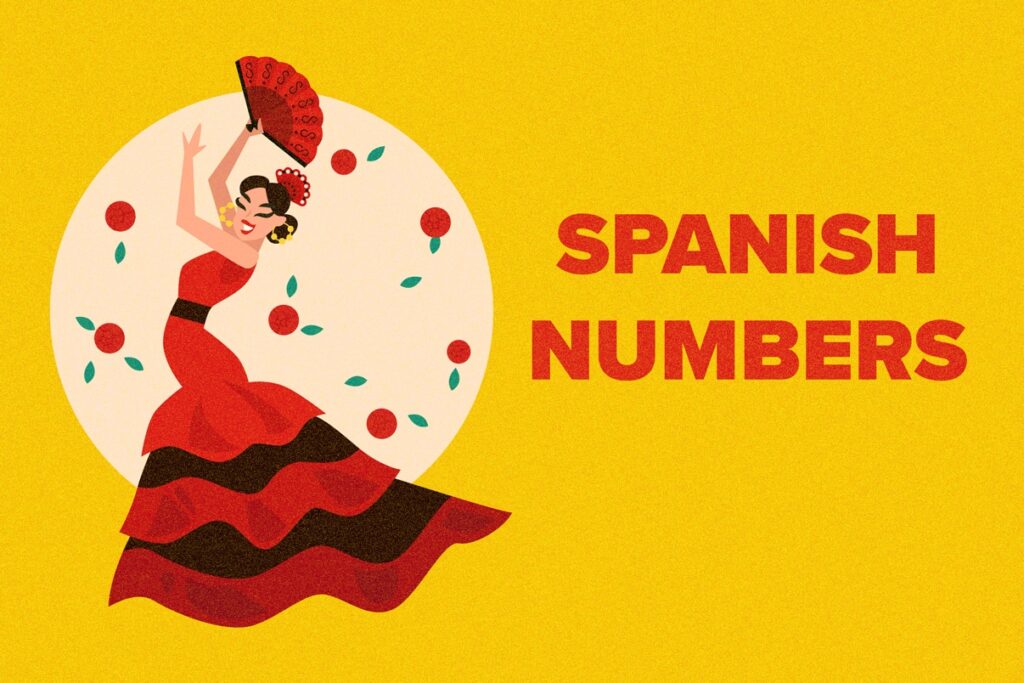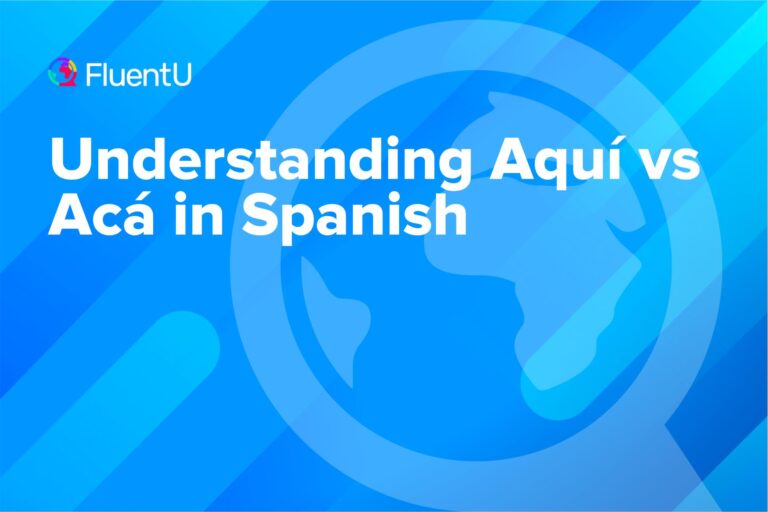Numbers in Spanish from 1 to 100 and Beyond

Knowing numbers and how to count in Spanish is crucial for basic conversational topics, whether you’re asking about prices while shopping, telling someone what time to meet you somewhere, or telling someone what year you were born.
After reading this post, you’ll be familiar with everything you need to know about Spanish numbers, including how to count from one to a billion, grammar rules for numbers and ordinal numbers.
You can also take a look at our story-based lesson on Spanish numbers:
Download: This blog post is available as a convenient and portable PDF that you can take anywhere. Click here to get a copy. (Download)
Spanish Numbers 1 to 10
| Number | Spanish (with Audio) |
|---|---|
| 1 | Uno |
| 2 | Dos |
| 3 | Tres |
| 4 | Cuatro |
| 5 | Cinco |
| 6 | Seis |
| 7 | Siete |
| 8 | Ocho |
| 9 | Nueve |
| 10 | Diez |
Note: When it comes before a masculine noun, uno becomes un. For example, un espejo (one mirror).
Spanish Numbers 11 to 30
| Number | Spanish (with Audio) |
|---|---|
| 11 | Once |
| 12 | Doce |
| 13 | Trece |
| 14 | Catorce |
| 15 | Quince |
| 16 | Dieciséis |
| 17 | Diecisiete |
| 18 | Dieciocho |
| 19 | Diecinueve |
| 20 | Veinte |
| 21 | Veintiuno |
| 22 | Veintidós |
| 23 | Veintitrés |
| 24 | Veinticuatro |
| 25 | Veinticinco |
| 26 | Veintiséis |
| 27 | Veintisiete |
| 28 | Veintiocho |
| 29 | Veintinueve |
| 30 | Treinta |
Note: See how dieciséis (16) is made up of diez (10) and seis (6), which together make 16? This idea of combining numbers will be a common theme throughout this post.
When they’re paired with masculine nouns, we also shorten numbers that end in uno to ún (note the accent). So it’s veintiún espejos (21 mirrors) because espejos is masculine.
Spanish Numbers 40 to 100
| Number | Spanish (with Audio) |
|---|---|
| 40 | Cuarenta |
| 50 | Cincuenta |
| 60 | Sesenta |
| 70 | Setenta |
| 80 | Ochenta |
| 90 | Noventa |
| 100 | Cien |
Note: To make specific numbers past 30, you have to use y (and) to connect the 10s with the 1s. For example:
33 is treinta y tres
65 is sesenta y cinco
For more practice with Spanish numbers 1 to 100, I recommend watching this comprehensive video from Butterfly Spanish on YouTube:
Spanish Numbers 100 to 1000
| Number | Spanish (with Audio) |
|---|---|
| 40 | Cuarenta |
| 50 | Cincuenta |
| 60 | Sesenta |
| 70 | Setenta |
| 80 | Ochenta |
| 90 | Noventa |
| 100 | Cien |
Note: Cien is only used to say 100 even—anything above that and we’ll use ciento.
There’s also no y used with these larger numbers because the y is only used to separate the 10s from the 1s (42 = cuarenta y dos) but not the 100s from the 10s (142 = ciento cuarenta y dos).
So, following this pattern, 104 is ciento cuatro. 147 is ciento cuarenta y siete not ciento y cuarenta y siete.
Also remember:
- Cien is used as an adjective before nouns, such as: cien naranjas, cien días. It’s also used as an adjective when followed by the numbers mil, millón, billón (ie. cien mil, cien millones, cien billones).
- Use ciento when attaching smaller numbers in the 10s and 1s: ciento cuarenta, ciento sesenta, etc. It’s also used in expressions or refrains, usually coming from old Spanish.
- When a number ends in ientos, the adjective (the number) agrees with the noun (the thing we are counting). For example: Seiscientos espejos, seiscientas mesas, etc.
Spanish Numbers 1,000 and Beyond
| Number | Spanish (with Audio) |
|---|---|
| 1000 | Mil |
| 100000 | Cien mil |
| 1000000 | Un millón |
| 1 Billion | Un billón |
| 1 Thousand million (a billion in the U.S. system) | Mil millones |
| Another word for a billion in the U.S. system | Un millardo |
Thousands
Beyond one thousand, you use the appropriate number to signify how many thousands you have. For example:
2,000 — Dos mil
3,006 — Tres mil seis
46,000 — Cuarenta y seis mil
46,155 — Cuarenta y seis mil, ciento cincuenta y cinco
Note: After mil, in Spanish, we use a period to separate our numbers instead of a comma, like we use in English. So 100,000 in English becomes 100.000 (cien mil).
Millions
Congratulations, you can now use these rules to count up to a million!
A million in Spanish is un millón or 1.000.000.
Let’s look at some examples:
4.000.000 — Cuatro millones
4.000.800 — Cuatro millones ochocientos
6.986.410 — Seis millones, novecientos ochenta y seis mil, cuatrocientos diez
Billions
And a un billón (a billion)? Well, that depends on which system you’re using, as there’s some debate about how many a billion actually is.
Officially, the whole world has now decided to go with the U.S. system, where a billion is a thousand million. But in practice, how many millions there are in a billion varies wherever you are.
If you need to be precise, it might be worth asking ¿Cuánto es un billón? (How much is a billion?).
The best way to pick up on these number rules is to immerse yourself as much as possible and listen to how natives pronounce things.
For example, you could use FluentU to watch authentic Spanish videos featuring native speakers in a variety of different contexts. Each video also comes with interactive subtitles, which let you hover over new words and structures you don’t know.
This is a pretty easy way to catch Spanish numbers used “in the wild” and learn other new terms in context.
FluentU takes authentic videos—like music videos, movie trailers, news and inspiring talks—and turns them into personalized language learning lessons.
You can try FluentU for free for 2 weeks. Check out the website or download the iOS app or Android app.
P.S. Click here to take advantage of our current sale! (Expires at the end of this month)

Spanish Numbers in Sequences or Orders
Ordinal numbers are words that describe a sequence or order, like “first,” “second,” “third,” etc.
We don’t use ordinal numbers for the date in Spanish (like in English), but you do need them to talk about things like floor numbers, directions and who has won competitions (“she won first prize,” for example).
| Number | Spanish (with Audio) |
|---|---|
| 1st | Primer (o/a) |
| 2nd | Segundo (a) |
| 3rd | Tercer (o/a) |
| 4th | Cuarto (a) |
| 5th | Quinto (a) |
| 6th | Sexto (a) |
| 7th | Séptimo (a) |
| 8th | Octavo (a) |
| 9th | Noveno (a) |
| 10th | Décimo (a) |
Note that these words are adjectives (because they describe a noun), so you have to make them masculine, feminine or plural, depending on what you’re talking about. For example:
El primer piso (the first floor)
Ella es la primera (she’s the first)
Son los primeros a ir de viaje en nuestro familia (They’re the first ones to go on holiday in our family)
Spanish Numbers Practice Quiz: Test Yourself!
Translate the following numbers into Spanish and see how many you can get correct.
So there you have it.
Spanish numbers are as easy as one, two, three—or uno, dos, tres!
Download: This blog post is available as a convenient and portable PDF that you can take anywhere. Click here to get a copy. (Download)
And One More Thing…
If you've made it this far that means you probably enjoy learning Spanish with engaging material and will then love FluentU.
Other sites use scripted content. FluentU uses a natural approach that helps you ease into the Spanish language and culture over time. You’ll learn Spanish as it’s actually spoken by real people.
FluentU has a wide variety of videos, as you can see here:

FluentU brings native videos within reach with interactive transcripts. You can tap on any word to look it up instantly. Every definition has examples that have been written to help you understand how the word is used. If you see an interesting word you don’t know, you can add it to a vocab list.

Review a complete interactive transcript under the Dialogue tab, and find words and phrases listed under Vocab.

Learn all the vocabulary in any video with FluentU’s robust learning engine. Swipe left or right to see more examples of the word you’re on.

The best part is that FluentU keeps track of the vocabulary that you’re learning, and gives you extra practice with difficult words. It'll even remind you when it’s time to review what you’ve learned. Every learner has a truly personalized experience, even if they’re learning with the same video.
Start using the FluentU website on your computer or tablet or, better yet, download the FluentU app from the iTunes or Google Play store. Click here to take advantage of our current sale! (Expires at the end of this month.)







